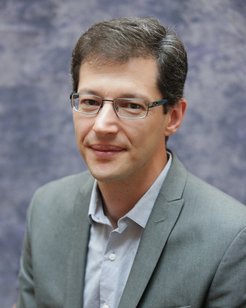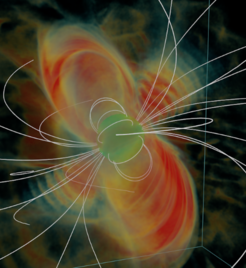Biermann Lectures 2019: Kinetic modeling of astrophysical plasmas
By Professor Anatoly Spitkovsky, Department of Astrophysical Sciences at Princeton University

The theoretical astrophysicist Spitkovsky uses high-performance computing to understand the physics of plasma in relativistic outflows, pulsar magnetospheres, and collisionless shocks, as well as studying phenomena related to accreting neutron stars. One of the central questions of high energy astrophysics is how particles can be accelerated to relativistic energies, resulting in nonthermal emission that we observe throughout the Universe. Shock waves, which occur when supersonic flows from supernovae or black hole jets slam into the surrounding medium, are thought to be responsible for the particle acceleration, yet how this works in practice is not fully understood. Spitkovsky studies this question using particle-in-cell (PIC) simulations of astrophysical shock waves, which allow first principles modeling of self-consistent dynamics of particles and fields. These simulations provide a glimpse of how plasma behavior in shocks leads to particle acceleration.

Another area that will be discussed in these lectures concerns pulsars, or strongly magnetized spinning neutron stars, emitting pulsed radio emission from their magnetospheres. Plasma feedback in the magnetosphere controls the rate at which pulsars slow down and how their rotational energy is converted into observable radiation. Spitkovsky developed a new numerical method for solving the equations of Force-Free Relativistic Magneto-hydrodynamics (MHD) to simulate the time-dependent evolution of a magnetosphere. Current research extends these MHD solutions to include self-consistent particle production and motion using kinetic PIC simulations. These simulations are used to model gamma-ray and radio emission from pulsars and open a new frontier in understanding relativistic magnetospheres.
Already at the beginning of his scientific career Spitkovsky was fascinated by pulsars; he obtained his his PhD from the University of California at Berkeley in 2002 with a thesis on "Pulsar winds and other burning questions of astrophysics". After several years as Chandra Postdoctoral Fellow at the UC Berkeley and the Kavli Institute for Particle Astrophysics and Cosmology (KIPAC) at Stanford University, he moved to Princeton University in 2006, where he now Professor in the Department of Astrophysical Sciences as well as Associated Faculty member at the Princeton Institute for Computational Science and Engineering. Since 2014, he is also Simons Foundation Investigator in Theoretical Physics.
Overall title:
Kinetic modeling of astrophysical plasmas
Friday, June14, 14:00:
Particle acceleration in astrophysical shock
Wednesday, June 19, 15:30:
The physics of pulsar magnetosphere
Friday, June 28, 14:00:
Creation, amplification, and destruction of magnetic fields
All lectures take place in the MPA Large Seminar Room E.0.11 and will be preceded by tea, coffee and cookies at 15 minutes before the lecture starts.

